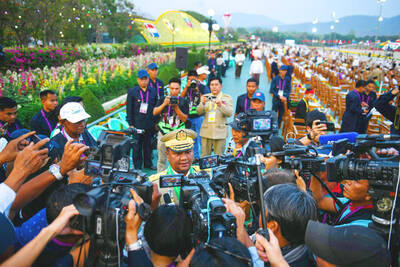China’s extraordinary historical treasures are under threat from increasingly aggressive and sophisticated tomb raiders, who destroy precious archeological evidence as they swipe irreplaceable relics.
The thieves use dynamite and even bulldozers to break into the deepest chambers — and night vision goggles and oxygen canisters to search them. The artifacts they take are often sold on within days to international dealers.
Police have already stepped up their campaign against the criminals and the government is devoting extra resources to protect sites and trace offenders. This year it set up a national information center to tackle such crimes.
Tomb theft is a global problem that has gone on for centuries, but the sheer scope of China’s heritage — with thousands of sites, many of them in remote locations — poses a particular challenge.
“Before, China had a large number of valuable ancient tombs and although it was really depressing to see a tomb raided, it was still possible to run into a similar one in the future,” said Wei Zheng (韋正), an archeologist at Peking University. “Nowadays too many have been destroyed. Once one is raided, it is really difficult to find a similar one.”
His colleague Lei Xingshan (雷興山) said: “We used to say nine out of 10 tombs were empty because of tomb-raiding, but now it has become 9.5 out of 10.”
Their team found more than 900 tombs in one part of Shanxi Province they researched and almost every one had been raided.
They spent two years excavating two high grade tombs from the Western Zhou and Eastern Zhou periods (spanning 1,100 BC to 221 BC) and found both had been completely emptied by thieves. “It really is devastating to see it happening,” Zheng said. “Archeologists are now simply chasing after tomb raiders.”
Experts say the problem became worse as China’s economy opened up, with domestic and international collectors creating a huge market for thieves.
Zheng said a phrase became popular in the 1980s: “If you want to be rich, dig up old tombs and become a millionaire overnight.”
However, he added that a crackdown by authorities was helping to contain the problem to an extent. According to the Chinese Ministry of Public Security, police investigated 451 tomb-raiding cases in 2010 and another 387 involving the theft of relics. In the first six months of that year, they smashed 71 gangs, detained 787 suspects and recovered 2,366 artifacts.
Those caught face fines and jail terms of three to 10 years, or life in the most serious cases.
Officials say tomb thefts have become increasingly professional. Gangs from the worst hit provinces — Shanxi, Shaanxi and Henan, which all have a particularly rich archeological heritage — have begun exporting their expertise to other regions. One researcher estimated that 100,000 people were involved in the trade nationally.
Wei Yongshun, a senior investigator, told China Daily last year that crime bosses often hired experienced teams of tomb thieves and sold the plunder on to middlemen as quickly as they could.
International collectors bear as much responsibility for the crimes as the actual thieves: the high prices they offer create the incentive for criminals.
“Stolen cultural artifacts are usually first smuggled out through Hong Kong and Macao and then taken to Taiwan, Canada, the US or European countries to be traded,” Wei said.
The sheer size as well as value of the relics demonstrates the audacity of the raiders — last year, the Chinese authorities recovered a 27 tonne sarcophagus that had been stolen from Xian and shipped to the US.
“If we don’t take immediate and effective steps to protect these artifacts, there will be none of these things left to protect in 10 years,” Luo Xizhe of the Shaanxi provincial cultural relics bureau told the China Daily.

Eleven people, including a former minister, were arrested in Serbia on Friday over a train station disaster in which 16 people died. The concrete canopy of the newly renovated station in the northern city of Novi Sad collapsed on Nov. 1, 2024 in a disaster widely blamed on corruption and poor oversight. It sparked a wave of student-led protests and led to the resignation of then-Serbian prime minister Milos Vucevic and the fall of his government. The public prosecutor’s office in Novi Sad opened an investigation into the accident and deaths. In February, the public prosecutor’s office for organized crime opened another probe into

RISING RACISM: A Japanese group called on China to assure safety in the country, while the Chinese embassy in Tokyo urged action against a ‘surge in xenophobia’ A Japanese woman living in China was attacked and injured by a man in a subway station in Suzhou, China, Japanese media said, hours after two Chinese men were seriously injured in violence in Tokyo. The attacks on Thursday raised concern about xenophobic sentiment in China and Japan that have been blamed for assaults in both countries. It was the third attack involving Japanese living in China since last year. In the two previous cases in China, Chinese authorities have insisted they were isolated incidents. Japanese broadcaster NHK did not identify the woman injured in Suzhou by name, but, citing the Japanese

RESTRUCTURE: Myanmar’s military has ended emergency rule and announced plans for elections in December, but critics said the move aims to entrench junta control Myanmar’s military government announced on Thursday that it was ending the state of emergency declared after it seized power in 2021 and would restructure administrative bodies to prepare for the new election at the end of the year. However, the polls planned for an unspecified date in December face serious obstacles, including a civil war raging over most of the country and pledges by opponents of the military rule to derail the election because they believe it can be neither free nor fair. Under the restructuring, Myanmar’s junta chief Min Aung Hlaing is giving up two posts, but would stay at the

YELLOW SHIRTS: Many protesters were associated with pro-royalist groups that had previously supported the ouster of Paetongtarn’s father, Thaksin, in 2006 Protesters rallied on Saturday in the Thai capital to demand the resignation of court-suspended Thai Prime Minister Paetongtarn Shinawatra and in support of the armed forces following a violent border dispute with Cambodia that killed more than three dozen people and displaced more than 260,000. Gathered at Bangkok’s Victory Monument despite soaring temperatures, many sang patriotic songs and listened to speeches denouncing Paetongtarn and her father, former Thai prime minister Thaksin Shinawatra, and voiced their backing of the country’s army, which has always retained substantial power in the Southeast Asian country. Police said there were about 2,000 protesters by mid-afternoon, although